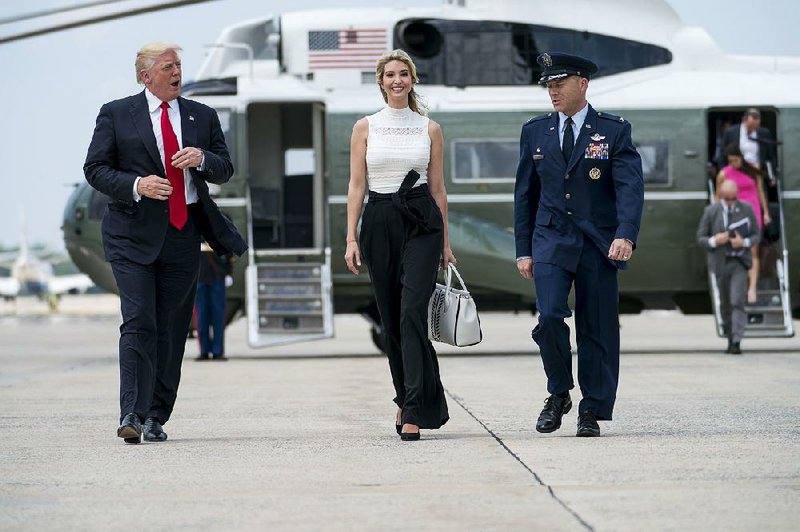WASHINGTON -- President Donald Trump said Tuesday that the nation needs a stronger system of apprenticeship to match workers with millions of open jobs.
"I love the name apprentice," Trump declared, referring to his reality TV show, The Apprentice. He said he wants every high school in the U.S. to offer apprenticeship opportunities and hands-on learning.
Joined in Wisconsin by daughter Ivanka Trump, Education Secretary Betsy DeVos and Labor Secretary Alex Acosta, Trump described his push to get private companies and universities to pair up and pay the cost of such arrangements.
"It's called earn while you learn," Trump said of his initiative during a visit to Waukesha County Technical College.
[PRESIDENT TRUMP: Timeline, appointments, executive orders + guide to actions in first 100 days]
The president toured a classroom full of tool-and-die machines that simulated a factory floor, accompanied by Wisconsin Gov. Scott Walker.
The White House said Trump's push is aimed at training workers with specific skills for particular jobs that employers say they can't fill at a time of low unemployment.
However, the most recent budget for the federal government passed with about $90 million for apprenticeships, and Trump so far isn't proposing to add more.
The Trump administration has said there's a need that can be met with a change in the American attitude toward vocational education and apprenticeships. A November 2016 report by former President Barack Obama's Commerce Department found that "apprenticeships are not fully understood in the United States," especially by employers, who tend to use apprentices for a few hard-to-fill positions but not as widely as they could.
The shortages for specifically trained workers cut across multiple job sectors beyond construction trades. There are shortages in agriculture, manufacturing, information technology and health care.
Participants in some apprentice programs get on-the-job training while going to school, sometimes with companies footing the bill.
IBM, for example, participates in a six-year program called P-TECH. Students in 60 schools across six states begin in high school, when they get a paid internship, earn an associate's degree and get first-in-line consideration for jobs from 250 participating employers.
But at the Wisconsin event, the president also heard more broadly about vocational education.
Ella Johnson told the president that she had graduated from Waukesha West High School last weekend and received a certification in welding two weeks earlier from the technical college as part of a dual enrollment program.
"I plan on welding for a good part of my life, until retirement," she said.
Sen. Tammy Baldwin, D-Wis., said Trump's "rhetoric doesn't match the reality" of budget cuts he's proposing that would reduce federal job training funding by 40 percent from $2.7 billion to $1.6 billion.
"If you're really interested in promoting apprenticeship, you have to invest in that skills training," said Mike Rosen, president of the Milwaukee chapter of the American Federation of Teachers union.
Apprenticeships are few and far between. Of the 146 million jobs in the United States, about 0.35 percent -- or slightly more than a half-million -- were filled by active apprentices in 2016. Filling millions more jobs through apprenticeships would require the government to massively ramp up its efforts.
"Scaling is the big issue," said Robert Lerman, a fellow at the Urban Institute.
Another complication: Only about half of apprentices finish their multiyear programs, Lerman said. Fewer than 50,000 people, including 11,104 in the military, completed their apprenticeships in 2016, according to the Labor Department.
The Trump administration has yet to spell out how it would close the completion gap.
Acosta said Monday that the policy would revolve around encouraging more partnerships between business and schools rather than increasing the $90 million the federal government currently devotes to apprenticeships.
"I want to challenge the assumption that the only way to move policy is to increase government spending," Acosta said at the White House news briefing Monday. "We should measure success based on outcomes and not simply based on spending."
The president attended a private fundraiser for Walker later Tuesday. Wisconsin was a key part of Trump's 2016 election triumph, as he became the first Republican to carry the state in a presidential election since 1984.
Trump also met on an airport tarmac in Milwaukee with four people he described as "victims" of the 2010 health care law.
Trump said the law was "one of the greatest catastrophes that our country has signed into law, and the victims are innocent, hardworking Americans." He singled out Michael and Tammy Kushman of Marinette County and Robert and Sarah Stoll of Kenosha.
Information for this article was contributed by Scott Bauer and Laurie Kellman of The Associated Press.
A Section on 06/14/2017
